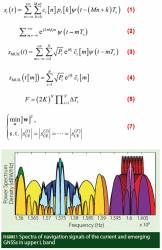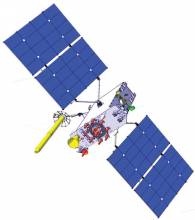 Loctronix SCP technology
Loctronix SCP technology[Updated 4/26/09] On March 31, the U.S. Patent Office granted Loctronix Corporation its first patent, which will provide the foundation for its Spectral Compression Positioning (SCP) technology that enables multi-source positioning capability in a single sensor. Subsequently, the company announced that it had successfully achieved meter-level ranging performance using CDMA cellular signals.
[Updated 4/26/09] On March 31, the U.S. Patent Office granted Loctronix Corporation its first patent, which will provide the foundation for its Spectral Compression Positioning (SCP) technology that enables multi-source positioning capability in a single sensor. Subsequently, the company announced that it had successfully achieved meter-level ranging performance using CDMA cellular signals.
Entitled “System and Method for Positioning in Configured Environments,” the patent (USPN 7,511,662) encompasses the methods and building blocks for implementing seamless, high-accuracy positioning solutions that are able to simultaneously utilize GPS/GNSS, regional cellular, and local-area beacon signals with a relatively simple, unified sensor implementation, according to the company.
“SCP technology makes it possible to deliver precise positioning for mobile devices in all environments with one sensor,” said Loctronix’ chief scientist, Peter F. MacDoran. “We are very excited by this patent award as it marks a major milestone for the company in its pioneering work to unify positioning methods.”
Established in 2006 and headquartered in Woodinville, Washington, Loctronix hopes to cash in on the growing demand for continuous, accurate location information across wide areas and different environments, including indoors.
In an interview with Inside GNSS, MacDoran explained that SCP exploits codeless spread spectrum signal and spectral compression techniques broadcast in the unlicensed Industrial, Scientific, and Medical (ISM) band of the radio spectrum, rather than at GNSS frequencies. In the case of Loctronix, signals are typically transmitted across 30 or more MHz around the 2.46 GHz band where some Wi-Fi (802.11b/g) equipment operates, but ISM is also available at 902–928 MHz, 2.4 GHz and 5.7–5.8 GHz.
Because spread spectrum signals have a very low spectral density, MacDoran says “wi-fi can’t see us, and we can’t see it,” allowing the two technologies to operate in the same RF space.
Unlike the navigation messages transmitted onto GNSS signals using pseudorandom noise codes, SCP uses codeless positioning techniques.
“We listen to quasars all the time,” says MacDoran, “and we don’t know their code.” Indeed, it was while working at the Jet Propulsion Lab in the early 1980s that MacDorran developed and patented a technique for codeless GPS positioning.
Instead, he says, codeless techniques — both GNSS and SCP — collapse the spectrum and go after the chipping rate using the well-known “delay and multiply” technique. Loctronix beacons transmit a 300 byte message at 5 and 15 MHz chipping rates to enable, respectively, coarse and precise positioning by the SCP sensor.
SCP uses a “floating datum” or local coordinate frame, MacDoran says, but part of Loctronix’s IP ties those local coordinates to the World Geodetic System 1984 (WGS84) in terms of which GPS operates.
In recent tests, company personnel used Loctronix’s first-generation Model 1000 series SCP sensor and an omnidirectional antenna to pick up any CDMA-2000–compliant signals between 1.85 and 1.99 GHz in the vicinity of its Colorado Springs, Colorado, office.
“Using a spectrum analyzer and a high gain antenna, we were able to identify several [CDMA] base station forward links,” says Michael B. Mathews, Loctronix’s president and chief architect. “We identified a particular forward link at 1.966 GHz and processed it using our SCP sensor. We believe the signal originated from a Sprint base station. . . . We have not yet identified the particular tower or precise location. We will tackle those points in future work.”
A second experiment evaluated the phase ranging measurement precision of the Model 1000 with the CDMA signal and using differential methods. According to Mathews, the company was able to reliably produce ranging measurement precisions better than 1.5 meters.
Last year, Loctronix announced that its SCP sensor had successfully tracked signals from GPS and GLONASS satellites, processing the signals on a software defined radio (SDR) platform.
At the time, Mathews said the test “demonstrates that Loctronix can, in fact, track signals from any broadband positioning system with a single sensor, enabling positioning of people or assets everywhere, be they indoors, outdoors or even underground.”
In both indoor and outdoor environments, the accuracy was approximately one-meter circular error probable (CEP), which has been the system design goal, Mathews told Inside GNSS. The receiver is codeless and makes use the P(Y) channel in a differential mode).
The SDR used in the demonstrations is the commercially available Ettus Research USRP hardware developed as a part of the GNU-Radio project. The USRP is used for both beacons and receivers, with separate daughter boards (RFX 2400 for beacon transmitter, and DBSRX for GNSS and beacon receivers).
However, the technology demonstrations were performed using proprietary firmware and software developed by Loctronix rather than the software methods typically used by the GNU-Radio community.
“The real value of SDR is its flexibility — we can tune to any GNSS frequency, as well as ranging signals from local and regional beacons, without the need for highly specialized and complex electronics hardware. The SDR implementation of SCP shows the inherent simplicity and elegance of the technology, which can provide meter-level positioning accuracy at minimal cost and power consumption,” Mathews stated.
According to Mathews, the SCP receiver can track both GNSS and beacon signals simultaneously, and is capable of auto switching — that is, a platform is tracked outdoors with GPS, then when it moves indoors, the system seamlessly (without stopping or requiring user intervention) switches to a beacon tracking mode. The reverse scenario, tracking with beacons indoors then moving outdoors, has also been demonstrated.
The next-generation reference design, the Model 2000, will be tri-band capable, allowing full simultaneous acquisition of GPS (L1), 1.9 GHz CDMA, and 2.4 GHz CDMA, Mathews says.
“Using the Model 1000, for example, we can look at the C/A and P(Y) of the GPS as well as Coarse and Precision channels of our beacons simultaneously. To bring in the CDMA or other bands requires reassignment of at least one channel and RF input.
“In the Model 1000, we can switch between bands in a few milliseconds [through software] during the data snapshot acquisition period we can cover all the bands sequentially if needed,” he says. “Our goal is to perform a complete snapshot acquisition in less than a second.”
Loctronix has lab-tested a four-channel SCP sensor design, enabling it to process four different observables simultaneously, and is currently developing a tri-band version with up to six processing channels, Mathews says, “which should cover pretty much all configuration variants we anticipate at this time. This will produce the fastest data snapshots as no [channel] switching is required.”
The system has also been tested with a daughter card devoted to GPS and with one devoted to beacons, tracking and positioning simultaneously.
According to Mathews, the testing was done by Loctronix personnel, with involvement from contractors, and the results were reviewed by a third-party partner of the company.
Currently Loctronix is focused on testing specific capabilities of the technology relative to partner requirements for applications in local and regional deployments that target commercial and, potentially, military segments. This includes both beacon-only and combined GPS/beacon applications. “We continue to explore and expand our test envelope using new signals of opportunities as time and partner interests permit,” Mathews said.
This includes manufacturing operations or first responders that want to locate personnel and assets inside large facilities, as well as defense agencies and military contractors interested in future combat systems and such applications as “blue force” (own personnel) tracking to avoid “friendly fire” incidents.
The company is offering a third-generation reference design to its prospective partners: manufacturers and large-scale electronics companies and wants to license the IP of the beacon, and sell and license the signal processing engine.
In explaining the real-world market implications for the SCP patent, Loctronix’ CEO Thomas P. Farmer notes, “Unified positioning technology is the logical next step for location-based services (LBS). Loctronix SCP technology dramatically reduces new infrastructure requirements. . . . By utilizing a single sensor to access all existing positioning services, signals of opportunity, and local beacons, we can deliver an affordable, seamless positioning experience across a broader landscape, which we believe will accelerate the growth of both consumer and commercial mobile applications,” Farmer says.





